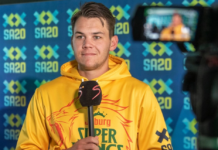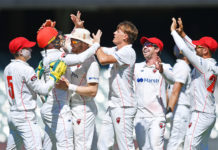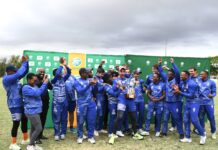Photo Credit: Cricket Netherlands
“Without good pitches and fields, no good cricket”, that is the motto of the accommodation committee (AC) of the KNCB. That is why all associations have recently received the ‘Manual for the installation and maintenance of cricket pitches with artificial turf’.
Why was it necessary to create this guide?
The accommodation committee of the KNCB (AC) aims to have good and, above all, reliable cricket pitches in the Netherlands at all levels. “There is no good cricket without good pitches and fields” is the AC’s motto.
An analysis that the accommodation committee (AC) made a few years ago shows that the situation around the cricket fields in the Netherlands is a cause for concern for the broadening of cricket and the promotion of top sport.
- Limited number of fields
- Too few fields available due to football competition run-off, maintenance, etc.
- Often of poor quality, too small, bad pitches, artificial grass outfield
- Too little knowledge among clubs and municipalities to build and maintain fields.
Based on the pitch reports that are prepared by bondsumpires at each match, the AC has found that there is a big difference in quality in cricket pitches. A number of associations do little or nothing about maintenance and a number of clubs have been playing on the same raw pitch for years.
The difference in quality in the current cricket pitches in the Netherlands is mainly caused by insufficient maintenance or by the use of materials that may be cheaper when purchased, but in the longer term do not provide the desired result.
It was clear that it was necessary to improve the knowledge of clubs and municipalities to build and maintain fields including pitches.
What did it take to make this happen?
First of all, a separate project to develop standards for cricket pitches in consultation with NOC*NSF. In 2021, the KNCB, in collaboration with the accommodation committee, had tests carried out on several cricket pitches with an artificial turf. The results of these tests have been instrumental in determining the standard drawn up by the KNCB together with NOC*NSF in collaboration with two external parties.
At the same time, a start was made on writing a manual for the construction and maintenance of pitches based on this standard. In 2021, the editing of the manual took shape, under the direction of the federal office, in collaboration with the accommodation committee. The first version of the Manual is now online.
What else is in the pipeline from the accommodation committee?
1. In 2022, as many THE pitches as possible will be measured to see whether they comply with the new standard. The KNCB will draw up a plan for this together with the accommodation committee.
2. Develop a future vision on accommodation policy together with the associations. This policy includes the following spearheads:
A Increase in the number of grass wickets
B Fields with an artificial grass outfield
C Sharing knowledge and skills
D Support for associations towards municipalities
A Importance of grass wickets
Grass pitches are the standard in international cricket. In order to keep up with international cricket, cricket must also be played on grass as much as possible in the Netherlands. Certainly at the highest level and also important in training talented youth players. The aim should in any case be to play all matches in the top class on grass. See also the plans of the Taskforce Competition. In which, in addition to top class cricket, it is also proposed to play a provincial competition and youth cricket U23, U17 and U14 on grass. More fields and more grass wickets are then conditions.
Playing on grass also fits in with the KNCB’s ambition to become a full member of the ICC. An approach will have to be developed in which way the number of grass wickets in the Netherlands can be expanded.
B Artificial grass pitches are a given
Pursuant to Article 27 of the Regular Competition Regulations, matches may not be played on synthetic turf pitches without permission from the board.
In practice, this means that annual dispensation requests from eleven associations are passed through the board with an automatic positive advice from the Accommodation Committee.
It is realistic to consider that the number of synthetic turf pitches will continue to grow in the future and will be indispensable for the further growth of cricket in the Netherlands. It is therefore more logical in the future to automatically allow cricket with an artificial grass outfield. With the exception of the highest level in addition to the provisions under A and also with the requirements set by the KNCB for synthetic turf pitches.
C Sharing knowledge and skills
In practice, it appears that there is a lot of room for improvement of knowledge and skills at clubs and municipalities to build and maintain fields and pitches. There is therefore a need to increase this knowledge by organizing courses/workshops and by providing support to associations with experts. The KNCB will draw up a plan for this. In addition, it also proves useful if the KNCB helps the associations in discussions with the municipality.
D Support to associations towards municipalities
Professional parties are involved in the construction of new fields and pitches: municipalities, contractors, green companies, suppliers of mats and shock pads, inspection institutes, etc. How do associations deal with all these parties?
Where necessary, the KNCB provides support to associations in these contacts. Initiatives to establish new clubs deserve very serious attention. Support from the KNCB can also be important here. Cricket is the 2nd sport in the world and also deserves a place in the multicultural society in the Netherlands.
Other:
- Analysis and assessment reports of bondsumpires regarding quality fields and pitches.
- Annual update of the Accommodation Regulations.
- Advice to associations about their accommodations.
Current composition of the AC:
Frits de Jongh (chairman), Theo Sikkema, Willem Ligtenstein, Patrick Gorlee (members), Tom Heggelman (contact person KNCB national bureau).

















































